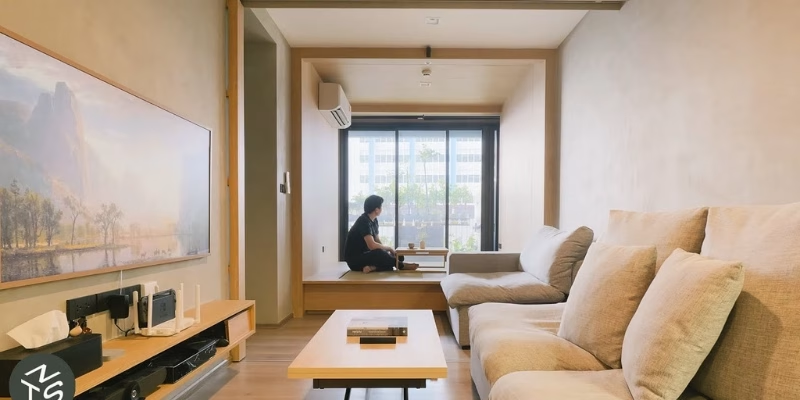Looking for a place to live in Japan apartment for sale in tokyon, especially in cities like Tokyo, Osaka, or Nagoya? One of the most important things to understand before signing a lease or buying a property is the Japanese apartment floor plan. Unlike Western-style listings, Japanese real estate uses a unique system of abbreviations, measurements, and layout terminology that can be confusing for foreigners. This guide will help you decode them while offering insights into 2LDK apartments in Tokyo, average apartment sizes, and the relationship between income levels and housing choices in Japan.
What Is a Japanese Apartment Floor Plan?
A Japanese apartment floor plan shows more than just room measurements. It gives you a clear view of how the space works. You can see how each area connects, how many bedrooms there are, where the kitchen and dining room sit, and whether the design follows an open or closed layout.
The floor plan also shows the apartment’s size, usually in square meters (m²) or tatami mats. This helps you understand how much actual living space you get, especially in Tokyo where space is limited and smart design matters.
Most layouts highlight key features like balconies, storage, built-in closets, and modular bathrooms, often marked as UB or Unit Bath. These details matter when you compare listings, especially if you’re looking for a family-friendly home such as a 2-bedroom apartment or a 2LDK unit in Tokyo.
If you plan to move or look for apartments for sale in Tokyo, learning how to read a floor plan helps you make better choices. You avoid surprises like mistaking a multipurpose space for a bedroom or discovering there’s no wall between the kitchen and living area. When you understand the layout, you can choose a home that truly matches your lifestyle and needs.

Smart Japanese Apartment Layout Design
A Practical Guide to Understanding Japanese Apartment Floor Plans
If you’re new to the Japanese housing market, deciphering an apartment floor plan can feel like learning a new language. Unlike Western listings that rely heavily on square footage and photos, Japanese real estate relies on compact, symbol-based diagrams filled with abbreviations. Once you get familiar with the system, however, these layouts become a powerful tool for quickly comparing options, especially when searching for 2 bedroom apartments in Tokyo or browsing listings that include 2LDK apartment Tokyo.
Let’s start with the basics. Floor plans in Japan commonly use letters to represent the types of rooms:
- L stands for Living Room
- D means Dining Room
- K refers to the Kitchen
- LDK is a common combination meaning a shared Living, Dining, and Kitchen area
- R indicates a general-purpose room, often used as a bedroom
- UB stands for Unit Bath, which includes a pre-fabricated bath and shower space
- WIC means Walk-In Closet, an increasingly popular feature in newer apartments
- 玄関 (Genkan) is the Japanese term for entryway or foyer, where shoes are removed before entering the main space
These abbreviations are then combined to indicate the apartment’s overall configuration. For example:
- 1K means one room with a separate kitchen, but no living or dining area. This is a popular choice among single residents or those on a tighter budget, particularly in urban areas like Tokyo.
- 2LDK refers to two separate bedrooms plus a living, dining, and kitchen area all within one open-concept space. It’s one of the most sought-after layouts among couples, small families, or professionals looking for comfort and flexibility.
- 3LDK expands on this idea, offering an extra bedroom, making it a good match for growing families or those needing a dedicated workspace or guest room.
When you’re apartment hunting in Tokyo, especially for 2 bedroom apartments in Japan, it’s common to come across listings labeled “2LDK apartment in Tokyo” or simply “2LDK Tokyo.” This shorthand helps agents and renters instantly identify the number of rooms and the general layout without needing to see the unit in person.
Understanding these codes is crucial because Japanese apartments are often compact, and the layout greatly affects livability. A 50m² 2LDK might feel more spacious than a 60m² 1LDK depending on how the space is divided. So, reading the floor plan carefully helps ensure the apartment will suit your needs, whether you’re a single professional, a couple relocating to Japan, or a family looking for a practical space in one of the 3 biggest cities in Japan.
By learning how to interpret these common layout terms, you’ll not only narrow down your search more efficiently but also avoid confusion or misaligned expectations during viewings or lease negotiations. It’s a vital skill whether you’re renting or planning to invest in an apartment for sale in Tokyo Japan.
Common Layouts in Japanese Apartments
When it comes to apartment living in Japan, the layout you choose has a major impact on comfort, convenience, and overall lifestyle. Japanese apartments are typically categorized by a combination of letters and numbers (like 1K or 2LDK), each representing a specific room configuration. These layouts often correspond with the life stage and income level of the resident, whether you’re living alone, with a partner, or with family.
1K / 1DK – Ideal for Singles and First-Time Renters
The 1K and 1DK layouts are among the most compact and budget-friendly floor plans available. A 1K apartment usually includes one main room and a small, separate kitchen, while 1DK adds a small dining area. These types of apartments are especially common in major cities like Tokyo and Osaka, where space comes at a premium.
These layouts are a smart choice for single professionals, students, or those just starting their career in Japan. For individuals earning around the average income in Japan, which in 2025 is approximately ¥330,000–¥370,000 per month, 1K units offer affordable rent without sacrificing too much comfort. They’re often located near train stations, universities, or business hubs, which makes commuting easy and cost-effective.

Compact 1K Apartment in Tokyo
1LDK / 2LDK – Great for Couples or Small Families
As your space needs grow, layouts like 1LDK or 2LDK become more appealing. In these apartments, you’ll find one or two bedrooms alongside an open-concept living, dining, and kitchen area. This type of layout strikes a solid balance between affordability and functionality.
For those searching for 2 bedroom apartments in Tokyo, the 2LDK apartment Tokyo layout is among the most widely available. It provides enough room for a bedroom, a guest room or home office, and a shared family area—ideal for working couples, digital nomads, or small families.
When it comes to cost, 2 bedroom apartments in Tokyo price can range from ¥120,000 to ¥250,000 per month, depending on the building’s location, age, and amenities. The average apartment rent in Tokyo for a 2LDK unit is typically around ¥180,000, making it an attainable option for those earning close to or slightly above the median income in Japan, especially in dual-income households.

2 Bedroom Layout for Families
3LDK or Larger – Suitable for Families or Long-Term Residents
If you’re relocating with children or planning a more permanent move to Japan, a 3LDK layout (three bedrooms plus living/dining/kitchen) or even larger apartments are worth considering. These spacious floor plans are typically found in suburban areas or higher-end residential buildings in cities.
Families with school-aged children or multigenerational households will appreciate the extra rooms for sleeping, studying, and relaxing. These layouts also allow more privacy and storage, which are often limited in smaller units.
If you’re exploring real estate investment or long-term living options, there are many apartments for sale in Tokyo that follow this layout. One well-known example is apartment Setagaya, located in one of Tokyo’s most family-friendly and livable wards. Setagaya offers excellent public schools, green spaces, and a strong sense of community, making it a top choice for both Japanese families and foreign buyers alike.

Setagaya 3LDK Apartment Option
Unique Features in Japanese Floor Plans
Japanese apartments are known for their smart design and efficient use of space. Whether you’re renting a studio or a 2 bedroom apartment in Japan, several unique features often stand out in the layout.
One of the most recognizable is the genkan, or entryway, where residents remove their shoes before entering the main living area. This small space usually includes a shoe cabinet and marks the boundary between outside and inside.
Another key feature is the separation of the toilet and bath. Unlike Western-style bathrooms, most Japanese floor plans divide these areas, allowing multiple people to use them at the same time. The bath is usually part of a Unit Bath (UB), a compact but functional shower and tub combination.
Many traditional or mixed-style apartments include tatami rooms, which use straw mats as flooring. These rooms can serve as a guest room, study, or even a bedroom with a futon. Even in modern 2LDK apartments in Tokyo, a small tatami space is sometimes added for versatility.
Japanese apartments also prioritize built-in storage, from deep closets to overhead cabinets. This is especially useful in city apartments where space is limited.
Lastly, nearly all units feature a small balcony, mainly used for drying clothes. Even in compact layouts, these balconies are functional and reflect how Japanese homes blend practicality with tradition.
These design elements are part of what makes the Japanese apartment layout so efficient. Even compact 2 bedroom apartments Japan offers are built with daily convenience in mind.

Modern 2LDK with Tatami Room
Choosing the Right Floor Plan Based on Your Lifestyle and Income
When searching for an apartment in Japan, choosing the right layout depends largely on your lifestyle needs and income level. From compact units for singles to spacious family-sized apartments, understanding what fits your situation can help you make a smarter housing decision.
If you live alone, a 1K or 1LDK layout is often the most affordable and space-efficient option. These apartments are perfect for single professionals, students, or first-time renters, especially those earning around the average income in Japan per month, estimated at ¥330,000–¥370,000 (roughly $2,200–$2,500 USD) in 2025.
For couples or small families, a 2LDK apartment in Tokyo provides two bedrooms and a combined living-dining-kitchen area, striking a good balance between space and budget. This type of layout is ideal for dual-income households or those earning close to the average household income in Tokyo, which ranges from ¥6.5 to ¥7.5 million per year.
Considering long-term living or buying real estate in Japan? A larger 3LDK layout might be the better choice, especially in suburban areas like outer Tokyo or Aichi Prefecture. While the apartment cost in Tokyo can be high, there are still valuable options listed as apartments for sale in Tokyo Japan, particularly for families or foreign investors looking for stable assets.
It’s important to match your floor plan with your financial situation. For context:
- The average salary in Japan (2025) is around ¥4.5 to ¥5.2 million per year
- In Tokyo, many professionals earn over ¥6.5 million annually
- Meanwhile, in areas like Aichi, the minimum wage in 2025 is approximately ¥1,050 per hour, which makes smaller and more affordable units especially practical
Whether you’re renting a modest 1K or buying a spacious 3LDK, aligning your housing choice with your income and lifestyle will help you live more comfortably in Japan’s competitive housing market.
Where to Find Japanese Apartment Floor Plans Online
If you’re planning to rent or buy an apartment in Japan, one of the best ways to start is by browsing online platforms that specialize in real estate listings. These websites typically include not just prices and photos, but also detailed Japanese apartment floor plans, giving you a clear understanding of the layout before scheduling a visit.
Some of the most trusted and widely used sites include Suumo, Homes, and Arealty. These platforms cater to both Japanese and foreign audiences and often feature filters that make it easy to search by floor plan type, location, rent, or property type. When using these tools, try filtering by common layout keywords like “2LDK” (for two-bedroom units) or by the Japanese term “間取り図”, which means “floor plan diagram.” This is especially useful if you’re looking for properties in major cities such as Tokyo, Osaka, or Nagoya, the three biggest cities in Japan with the highest rental demand.
Understanding the typical apartment size is also important during your search. The average apartment size in Japan for a standard 2LDK is usually between 65–70 square meters, offering enough space for couples or small families. However, in Tokyo where space is more limited, the average apartment size in Tokyo for a 2LDK is slightly smaller, ranging from 55 to 65 square meters.
Whether you’re searching for a 2 bedroom apartment in Tokyo, browsing for an apartment for sale in Tokyo Japan, or just comparing layouts across prefectures, these online platforms provide essential details to help you make informed choices. Reviewing floor plans carefully will ensure the space meets your needs, not just in terms of size, but also layout efficiency and overall livability.

Explore 2LDK Listings in Tokyo
Conclusion
Understanding a Japanese apartment floor plan helps you avoid unnecessary stress and make smarter choices, whether you’re renting on minimum wage in Japan, browsing apartments in Tokyo for sale, or looking for better space value in the suburbs. Always compare layouts, consider your income level like the average income in Tokyo Japan, and check real photos or diagrams. Platforms like Arealty.jp make it easy to explore floor plans and find a layout that truly fits your lifestyle, not just your budget.






Leave a Reply